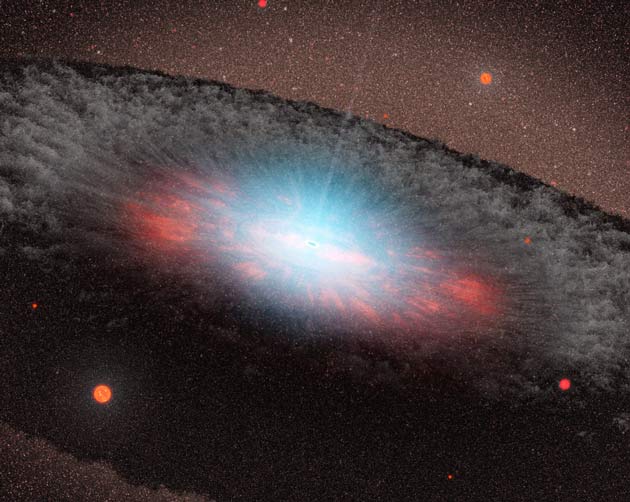Huge Black Holes Stifle Star Formation

Supermassive black holes play a stealthy role in two major types of galaxies in the universe, bulking up until they are big enough to effectively shut down the formation of new stars, scientists have found.
The new results explain why scientists have observed in the past that massive galaxies have fewer young stars. Black holes, monstrous heaps of dense matter, grow at a different rate than the galaxies that surround them. But once a black holes reach a critical mass and become too large for its host galaxy, it zaps away nearly all the gas needed for young stars to form.
"Supermassive black holes in these giant galaxies create unfriendly places for stars to form," said Sukyoung K. Yi of Yonsei University in Seoul, who led the research team. "If you want to find lots of young stars, look to the smaller galaxies."
The findings by Yi, Kevin Schawinski and Sadegh Khochfar of Oxford University and their colleagues were published last month in the journal Nature.
Expelling gas
In the past, scientists predicted that black holes suppressed star formation in their host galaxies by heating and expelling all the cold gas that is needed for star birth. Data from by NASA's Galaxy Evolution Explorer, or GALEX, spacecraft, launched in 2003, allowed Yi and his team to test that idea.
GALEX, which orbits Earth and is extremely sensitive to ultraviolet radiation emitted by even low numbers of young stars, has surveyed more than 800 nearby elliptical and lenticular (lens-shaped) galaxies of various sizes. The spacecraft's instruments turned up evidence that once a black hole reaches a certain size, it gets into a feedback loop with its host galaxies that results in conditions that suppress new star formation.
Get the Space.com Newsletter
Breaking space news, the latest updates on rocket launches, skywatching events and more!
"Star formation can happen anywhere, as it inevitably happens whenever the surface density of cold gas is sufficiently high," Schawinski told SPACE.com. "What we are referring to is the black hole removing gas by heating and/or expelling it from the galaxy altogether."
Galaxies can contain a large amount of hydrogen gas. If that gas is sufficiently cold and dense, clouds of it collapse to form young stars. However, if the gas in elliptical and lenticular galaxies has been heated to very high temperatures, it becomes unavailable as fuel for star-formation.
Messy eaters
The removal or ejection of cold gas from the center of galaxies possibly is achieved in part by jets of energy that shoot from black holes.
Black holes are "messy eaters," Khochfar said.
As matter falls towards a black hole, momentum forces it to flatten out into a dense, hot disk. A lot of the matter never makes it into the black hole and is ejected in jets that travel at a significant fraction of light-speed, emanating from the poles of the black hole. Those jets might do such a good job of heating gas near the center of a galaxy that there is little fuel available for the creation of new stars, Yi said.
Astrophysicists suspected that the energy of supernova explosions might be involved in ejecting star fuel from galaxies, but in the case of massive elliptical galaxies, Yi said, only black holes are massive enough to halt all star formation on their own.
- Top 10 Star Mysteries
- Forces of Creation: Black Holes Spark Star Formation
- Milky Way's Big Black Hole Gets Downsized
- The Strangest Things in Space
- All About Black Holes
Join our Space Forums to keep talking space on the latest missions, night sky and more! And if you have a news tip, correction or comment, let us know at: community@space.com.

Robin Lloyd was a senior editor at Space.com and Live Science from 2007 to 2009. She holds a B.A. degree in sociology from Smith College and a Ph.D. and M.A. degree in sociology from the University of California at Santa Barbara. She is currently a freelance science writer based in New York City and a contributing editor at Scientific American, as well as an adjunct professor at New York University's Science, Health and Environmental Reporting Program.









